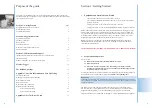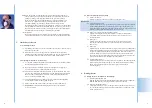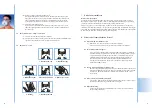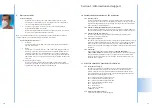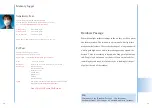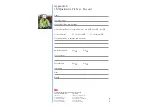
2.4 Practice fi t testing fi rst on a colleague
Practice a few times before conducting your fi rst actual fi t test.
2.5 Read HSE supporting material
Study the HSE Information Document 282/28 on Fit Testing. This can be downloaded
from the HSE website at www.hse.gov.uk (type HSE 282/28 in the search box).
2.6 Create a ‘Crib sheet’ or ‘Memory Jogger’
This will help you remember all the steps involved in the test. See our example on
page
12.
3. Equipment
and
Facilities
You will need the following on the day of the test:
•
Fit Test Kit (and alternative tasting solutions)
•
Record sheets (see suggested record card Appendix 2)
•
Clock or watch with second hand
•
Typed copy of ‘Rainbow’ passage in a large font for easy readability (see page 14)
•
Jug of water and glasses – preferably from a dispenser to avoid the fi t test aerosol
contaminating the water and glasses
•
Spare nebulisers (if possible, as these can get blocked)
•
Nebuliser ‘pin’ kit (to clear any obstruction if it gets blocked)
•
Samples of respirator to be tested
•
Selection of alternative models in case of failures
•
Table (big enough to lay out the Fit Test Kit)
•
Room with good ventilation to conduct fi t test & separate area/room for those
waiting to be tested
•
Room should be located near a toilet to allow hand/face washing post fi t-test
4. Pre test-day preparation
4.1 Communicate to persons to be Fit Tested:
(i)
Time
slots
We suggest each person has a specifi c 30 minute time slot for each respirator
being
tested.
TIP: It’s best to fi t test people individually so that they are not distracted by other
people in the room. Each test takes 20-40 minutes depending on whether the
person passes fi rst time. Time slots help avoid people waiting around.
(ii) Arriving on time
Ask them to arrive on-time and be cleanly shaven
(iii) Eating and drinking beforehand
They should not eat or drink anything other than water within 30 minutes of
their allocated time-slot.
This reduces the risk of food or drink consumed earlier leaving a residual taste in
the mouth that could be confused with a fi t test failure.
(iv) Provision of respirators for the test
Make it clear if people should bring their own, or if you will provide identical
models (sizes where appropriate) for the tests.
This applies if respirators have already been issued and fi t testing is being
carried out retrospectively.
If respirators have not already been issued, explain that one will be specifi ed and
provided at the time of the test.
(v)
Sensitivity
Test
TIP: If it is possible to do so, conduct the sensitivity test on a different day from the
actual
fi t test.
This reduces the risk of a false failure caused by any solution from the sensitivity
test that might remain in trace quantities on the hands, face or lips, being tasted
during the actual fi t test. If it is not practical to do this then be very careful to
avoid cross contamination by asking the person to wash their hands, face and lips,
especially after the sensitivity test and before starting the fi t test.
4.2 Check the equipment you need
(i)
Nebulisers:
Ensure they are washed and rinsed and that they work properly.
Saccharin can sometimes crystallise and block the nebuliser. If this happens the
bulb becomes hard to squeeze and no aerosol comes out. Use the pins provided to
unblock nebulisers. Spraying in front of a dark background makes it easier to see
the
fi ne mist emerging from the spout.
(ii)
Test
Solutions:
Check you have enough of each of the solutions.
On average one teaspoon should be enough to test 10 people. Each bottle should
be able to test about 150 people.
Section 2: Suggested Protocol
5
4


